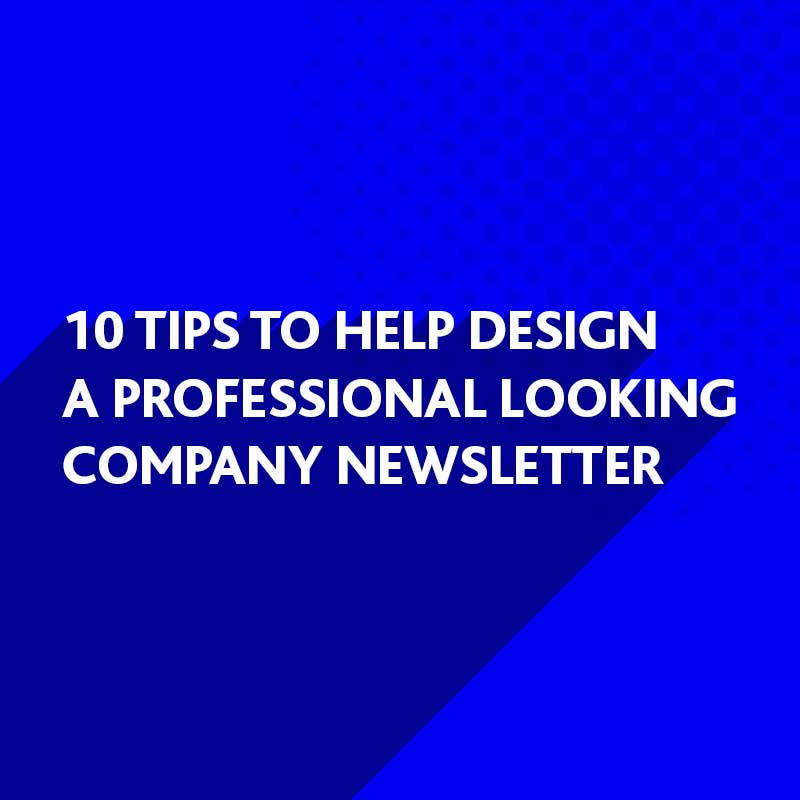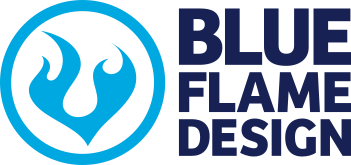
10 Tips for producing a professional Company Newsletter Design
A professional Company Newsletter Design can be a very powerful tool within a company’s business marketing arsenal.
So it’s easy to understand why many businesses will try and publish a company newsletter at some point, but the momentum will soon slow down and they will inevitably give up after a couple of editions. Basically, there are only two kinds of company newsletters: those that get read and those that don’t.
Through its design and content, a company newsletter design needs to capture the attention of a potential reader and keep it. It’s fair to say that a company newsletter will not get results if nobody reads it!
If you’re thinking of creating a newsletter for your company or if your existing newsletter needs to be refreshed, then here are 10 tips to make sure your newsletter gets read:
10 Tips for producing a professional Company Newsletter Design
1. Make your newsletter’s name an attention grabber
Too often, editors decide to focus their newsletter title on their company’s name rather than something that might draw in more attention and readers.
For instance, the local Billingshurst Chamber of Commerce creates a newsletter to attract more member subscriptions, promote their services within the local business community and advertise events they are involved with. Most editors would choose a generic sounding name for the newsletter like: The Billingshurst Chamber News.
This title might get the attention of readers who are already familiar with the Billingshurst Chamber of Commerce, but it’ll be less likely to capture the attention of someone who has never heard of them.
A much better name that would appeal to a wider segment of readers, would be ‘BilliBiz News’. This name would definitely pique the interest of the Chamber’s target market through the play on words: ‘Billi’ being short for Billingshurst, ‘Biz’ is a standard term for Business and … well, News speaks for itself. It’s fair to say that reading a copy of the new BilliBiz News sounds a lot more appealing and less stuffy than asking someone if they have seen the latest edition of The Billingshurst Chamber of Commerce News.
2. Write your newsletter’s articles objectively
Although a newsletter can be an excellent vehicle for promoting your company’s products and services, it shouldn’t read like a sales brochure. By its nature, a newsletter should be a ‘soft’ selling aid primarily providing useful information to readers. A newsletter that’s full of sales hype and propaganda will quickly be thrown into the recycling bin by potential readers.
A newsletter’s stories should be written more objectively, like the articles you’d find in a newspaper.
Base your articles on factual information and write them as if you were a neutral third party. Instead of writing a headline that screams ‘Our Business Branding Packages are the best in the world,’ try a more factual, third-person approach. A better headline would be: ‘Big Business Branding Success for Small Businesses thanks to BlueFlameDesign’s Budget Small Business Branding Packages’.
Also, when you insert opinions into your stories, make them into quotes and attribute them to the proper people in your organisation, just like a newspaper would.
3. Write to express, not to impress
The purpose of a newsletter is to communicate, not to see how many times you can send readers scrambling to find a dictionary. Don’t use big words when smaller words will do. A newsletter should be an ‘easy read’ so keep your writing casual, nontechnical and conversational.
When you use acronyms (CCTV, WSCT, etc.), don’t assume readers know what they stand for. List them out in the first reference, for instance, closed-circuit television (CCTV) and the West Sussex County Council (WSCC).
4. Proofread, proofread, proofread
You probably wouldn’t dream of sending out a curriculum vitiate to prospective employers that looks unprofessional, is full of typos and contains grammatical errors. That’s because your CV directly represents your professionalism to prospective employers.
In that same way, a newsletter represents the professionalism of your company to prospective customers and clients. You’ll want to make sure it looks impressive, has polished writing and is free of typos and grammatical errors. Proofreading, revising and rewriting are the most tedious, mundane parts of putting together a newsletter — but they are absolutely necessary.
5. Use front-page articles to draw in readers
It may be true that you can’t judge a book by its cover. But prospective readers do judge a newsletter by its cover. FACT. If the front page doesn’t contain interesting, useful articles, most people will glance at it, classify it as junk mail and throw it away without even reading a single story.
Just like the magazines you see in the newsagents like Vogue, GQ, Maxim and HEAT, your front page should feature the issue’s best articles and imagery that will draw in readers.
And remember: articles that are important to your company aren’t necessarily important to the average consumer.
For instance, some companies like to put regular features such as ‘A Message From the Managing Director’ or ‘A Letter From our Patron,’ on the front page, issue after issue.
Although putting these articles on the front page may boost the ego of the company director or patron, they probably won’t draw in readers unless the person has some really monumental news to announce.
It’s OK to use these types of articles, just put them in the proper place within your layout. If the Managing Director or Patron has a message that’s less than earth-shattering, put the piece on an inside page and use a more attention-grabbing article on the front.
(Of course, if your Managing Director doesn’t agree, you better ignore this tip … and stay out of the unemployment line!)
6. Use at least one graphic per page
Graphics include photos, artwork, charts, pull quotes or even a coloured or shaded box behind an article.
Graphics are important for two reasons;
First of all, studies have shown that people are more likely to read an article if it contains a graphic such as a photo or a diagram. That’s because graphics, along with headlines, are the first things that readers’ eyes are drawn to when they turn to a new page.
Secondly, graphics within a story are important because they provide much-needed visual breaks from solid blocks of text. A page containing nothing but row after row of endless text does not look inviting to read. However, a story that contains strategically placed graphics that break up the text into smaller, less-imposing portions looks more visually pleasing and will attract more readers.
7. Use image-editing software to sharpen your photos
Few photos come from the developer with perfect contrast, colour and brightness levels. If you scan photos for your newsletter, be sure to electronically touch them up before you insert them into the layout. Otherwise, they’ll probably look ‘muddy’ or as if they were shot on ‘Mars’ in the final publication.
Most image-editing software programs, such as Adobe Photoshop, allow you to adjust the contrast, colour and brightness levels of a scanned photo.
8. Use accent colours and tints to make your newsletter more eye-catching
This tip applies to those who are not printing their newsletters in full colour, which can be quite expensive.
To be certain, a black and white newsletter is better than no newsletter at all. However, if your budget allows, add at least one accent colour to your newsletter’s design. This is called a ‘two-colour’ or ‘two-ink’ (black plus your accent colour) newsletter, to use printers jargon.
Your newsletter will be competing with colourful magazines, newspapers and other high-budget publications for your readers’ time. A splash of colour on your pages will make your newsletter much more visible to prospective readers.
Also, by using tints of your newsletter’s inks, you can print more colours for no extra cost. A tint is simply a lighter shade of one of your inks.
For instance, if you have a newsletter that uses dark blue as its accent colour, you could use your desktop-publishing program to colour certain elements with a 50 per cent tint of that blue ink, which would appear medium blue. A 25 per cent tint of the dark-blue ink would appear light blue.
The same applies to other colours. Using red as an accent colour, you could print lighter shades that appear pink. Tints of black will appear as various shades of grey and so on.
9. Provide the right artwork file to your printers
Talk to your assigned printers and make sure you can provide your newsletter artwork in the right file format and at the correct resolution. You will be surprised how many fantastic newsletter designs are let down at the final hurdle.
Images may need to be of a certain resolution for different print processes, for example, if you are having your company newsletter litho printed then artwork of at least 300dpi would be preferable. However, you can get away with a lower resolution with modern digital presses if need be but depending on the size of the image to be printed
This improved quality of higher resolution imagery will translate into sharper photos and graphics, smoother tints and a crisper, more-detailed overall appearance.
A reputable printer or friendly design agency (such as BlueFlameDesign) would oversee this for you so you don’t have too.
10. Use recycled paper
Keep the world’s trees and your readers happy by printing your newsletter on recycled paper if budgets allow. Even if you aren’t a tree-hugging muesli eater, I bet many of your readers are.
Unlike years past, there’s very little cost difference today between recycled and virgin paper. So there really isn’t any reason not to use recycled paper.
An important note when choosing paper: Remember, recyclable paper is not necessarily recycled paper. Also, many papers are made from small amounts of mill scraps that are recycled, but this isn’t truly recycled paper.
Instead, you’ll want to use paper that is at least partially made up of previously used paper, as you put in your recycling bins. To find out what portion of the paper was made from previously used paper, ask your printers for the paper’s post-consumer-fibre percentage. The higher the number, the more recycled paper was used. Commonly used recycled papers generally range between 10-50 per cent post-consumer fibre.
If you do print your newsletter on recycled paper, be sure to let readers know. Put “Printed on Recycled Paper” in small type at the bottom of your pages or in the masthead.
Hopefully, with these top 10 Tips, your company newsletter design will attract, engage and inform new readers whilst all the while keeping your company name at the front of peoples minds.
If you would like assistance in creating a new or revamped company newsletter design for your business then please contact BlueFlameDesign today. Together we can ignite your business brand and set your marketing alight!

I think a newsletter design is incomplete without having the aforesaid qualities. I will always keep in mind these tips while creating newsletter designs.